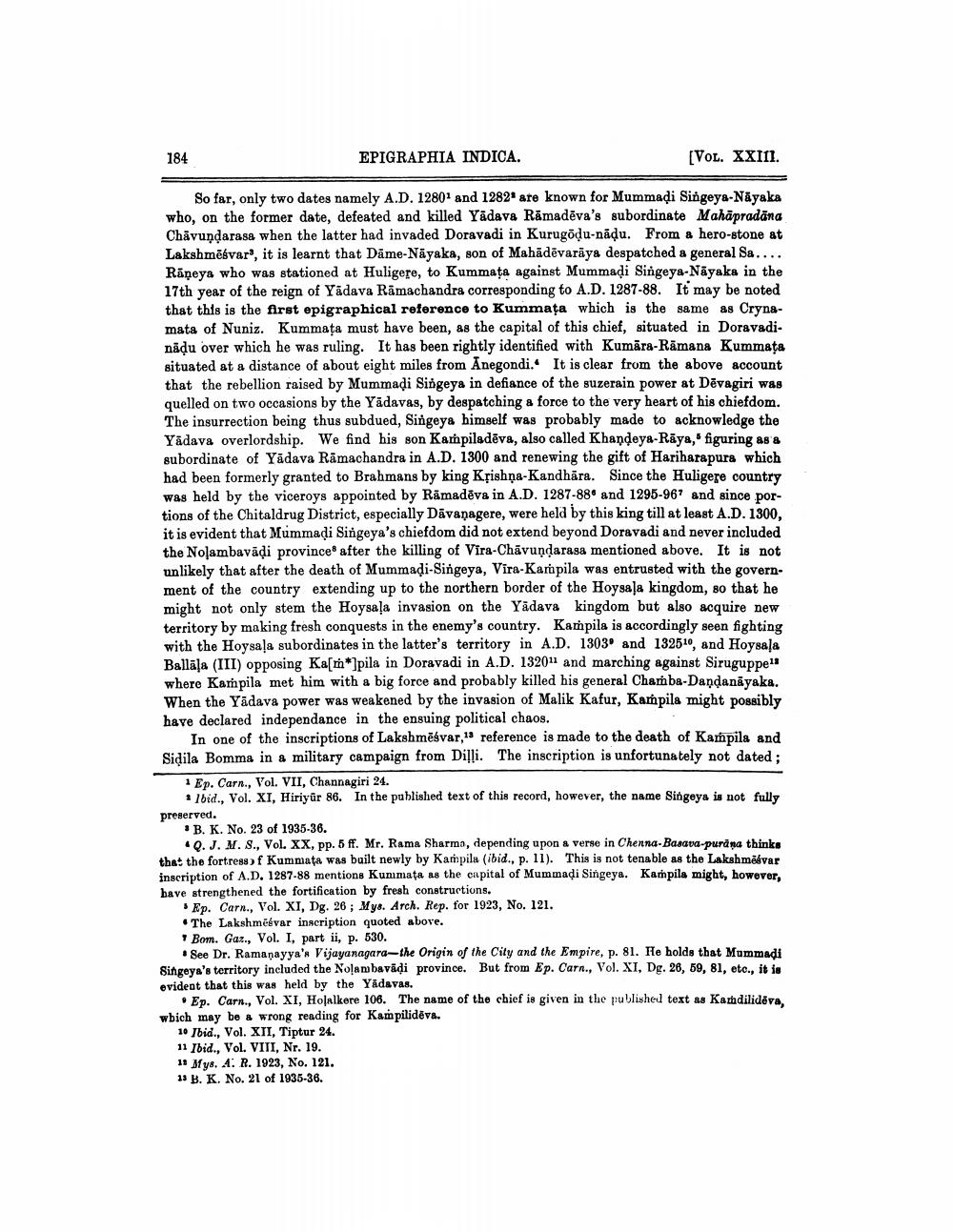________________
184
EPIGRAPHIA INDICA.
[VOL. XXIII.
So far, only two dates namely A.D. 12801 and 1282* are known for Mummadi Singeya-Näyaka who, on the former date, defeated and killed Yadava Rāmadēva's subordinate Mahāpradang Chāvundarasa when the latter had invaded Doravadi in Kurugõdu-nādu. From a hero-stone at Lakshmēsvar", it is learnt that Dāme-Näyaka, son of Mahādēvarāya despatched a general Sa.... Rāņeya who was stationed at Huligere, to Kummața against Mummadi Singeya-Nayaka in the 17th year of the reign of Yadava Ramachandra corresponding to A.D. 1287-88. It may be noted that this is the first epigraphical reference to Kummata which is the same as Crynamata of Nuniz. Kummaţa must have been, as the capital of this chief, situated in Doravadinadu over which he was ruling. It has been rightly identified with Kumara-Ramana Kummata situated at a distance of about eight miles from Anegondi. It is clear from the above account that the rebellion raised by Mummadi Singeya in defiance of the suzerain power at Dēvagiri was quelled on two occasions by the Yadavas, by despatching a force to the very heart of his chiefdom. The insurrection being thus subdued, Singeya himself was probably made to acknowledge the Yadava overlordship. We find his son Kampiladēva, also called Khandeya-Raya," figuring as & subordinate of Yādava Ramachandra in A.D. 1300 and renewing the gift of Hariharapura which had been formerly granted to Brahmans by king Kțishņa-Kandhāra. Since the Huligere country was held by the viceroys appointed by Rāmadēva in A.D. 1287-889 and 1295-967 and since portions of the Chitaldrug District, especially Dāvanagere, were held by this king till at least A.D. 1300, it is evident that Mummadi Singeya's chiefdom did not extend beyond Doravadi and never included the Nolambavādi province after the killing of Vira-Chāvundarasa mentioned above. It is not unlikely that after the death of Mummadi-Singeya, Vira-Kampila was entrusted with the government of the country extending up to the northern border of the Hoysala kingdom, so that he might not only stem the Hoysala invasion on the Yādava kingdom but also acquire new territory by making fresh conquests in the enemy's country. Kampila is accordingly seen fighting with the Hoysaļa subordinates in the latter's territory in A.D. 13039 and 13254, and Hoysala Ballāja (III) opposing Ka[m]pila in Doravadi in A.D. 132011 and marching against Siruguppels where Kampila met him with a big force and probably killed his general Chamba-Dandanayaka. When the Yādava power was weakened by the invasion of Malik Kafur, Kampila might possibly have declared independance in the ensuing political chaos.
In one of the inscriptions of Lakshmēsvar,1% reference is made to the death of Kampila and Sidila Bomma in a military campaign from Dilli. The inscription is unfortunately not dated :
1 Ep. Carn., Vol. VII, Channagiri 24.
1 lbid., Vol. XI, Hiriyur 86. In the published text of this record, however, the name Singeya is not fully preserved.
•B. K. No. 23 of 1935-36.
40. J. M. S., Vol. XX, pp. 5 ff. Mr. Rama Sharma, depending upon & verse in Chenna-Basara-purdna thinks that the fortressf Kummata was built newly by Kampila (ibid., p. 11). This is not tenable as the Lakshme var inscription of A.D. 1287-88 mentions Kummata as the capital of Mummadi Singeya. Kampila might, however, bave strengthened the fortification by fresh constructions.
Ep. Carn., Vol. XI, Dg. 26 ; Mys. Arch. Rep. for 1923, No. 121. • The Lakshmēsvar inscription quoted above. + Bom. Gaz., Vol. I, part ii, p. 530.
. See Dr. Ramanayya's Vijayanagara--the Origin of the City and the Empire, p. 81. He holds that Mummadi Singeya's territory included the Nolambavādi province. But from Ep. Carn., Vol. XI, Dg. 26, 59, 81, etc., it is evident that this was held by the Yadavas.
. Ep. Carn., Vol. XI, Holalkere 106. The name of the chief is given in the published text as Kamdilidēva. wbich may be a wrong reading for Kampilidēva.
10 lbid., Vol. XII, Tiptur 24. 11 Ibid., Vol. VIII, Nr. 19. 1: Mys. 4. R. 1923, No. 121. 13 B. K. No. 21 of 1935-36.




